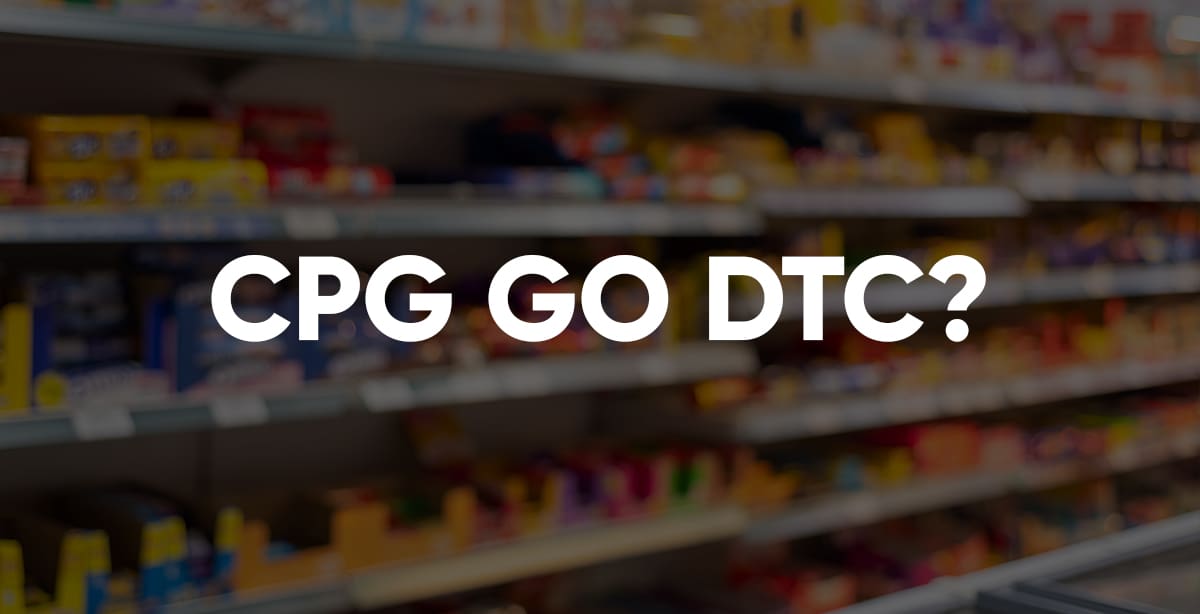For most consumer packaged goods (CPG) brands, the traditional route to the consumer goes squarely through retailers. And in the majority of cases, this approach makes perfect sense. After all, when the average consumer needs to replace everyday consumables like food items, beverages, cosmetics, over-the-counter medicines and other household products, they put them on their shopping list and head for the grocery store or drug store.
But in the digital age, consumers are increasingly researching and buying products of all kinds online. And especially in the wake of the COVID-19 pandemic, which greatly accelerated consumers’ shift to online buying, many CPG brands are even considering adding direct-to-consumer (aka DTC or D2C) online sales.
5 factors to consider before making the DTC move
The addition of DTC sales, though, is not one that should be taken lightly — and it raises a lot of important questions for CPG brands. Among them: Will consumers be willing to pay the added shipping costs needed to buy our offerings directly? Will adding DTC sales alienate our retail partners? Do we really want to compete with the biggest national retailers (think Walmart, Walgreens, AutoZone, etc.), all of which offer DTC sales already, for online consumers — especially if they’re already selling our products online? Have we tried maximizing our online sales efforts through these partners by leveraging their retail media platforms and first-party customer data?
In many cases, the leap to DTC simply won’t make a lot of sense for CPG brands. But in others, it can bring big sales boosts and added revenues. Before your CPG brand jumps into DTC sales, consider these five questions that may shed light on whether the tactic is a good fit for you:
1. Can you offer differences that your retailers don’t?
One shining example of a CPG brand finding success with DTC sales is M&M’s, which market researchers have identified as having a top DTC website among the CPG brands they evaluated. And one of the biggest drivers of the candy brand’s DTC success has been the product-customization options it offers via its online sales platform. To attract consumers and spur sales, the M&M’s website enables visitors to design their own personalized M&M’s candies, with the customization variables including color, design (including images and text) and packaging.
If your CPG brand can similarly find a way to offer consumers unique products or experiences that may not be available through your retail partners, this can create a distinct value proposition for your DTC offerings that gives consumers a compelling reason to go straight to the source. This differentiation can encompass exclusive product bundles, limited-edition releases or personalized options that cater to the preferences of individual consumers. These kinds of offerings not only help your brand connect with its audience on a more personal level, but they can also foster a sense of exclusivity and loyalty among consumers. And by offering something distinct through DTC channels, you avoid direct competition with your retail partners and enhance the overall brand experience for your customers, driving engagement and repeat business. Further, exclusive DTC offerings can provide your brand with opportunities to test new products, gather valuable consumer data and iterate quickly based on direct feedback, ultimately strengthening your brand’s market position.
2. Are you willing to design (or tweak) your offerings specifically for DTC?
When expanding to DTC sales, many brands attempt to sell their existing retail-channel offerings online without making any adjustments for the e-commerce environment. But it’s often advantageous to tailor your offerings to cater to the unique dynamics of online retail. For example, one significant advantage of e-commerce is the ability to optimize product packaging specifically for shipping efficiency, as opposed to the need for elaborate, eye-catching displays on store shelves. In the e-commerce realm, the packaging doesn’t have to serve the dual purpose of attracting attention and conveying information — rather, it’s more about functionality and sustainability. By focusing on eco-friendly packaging for their DTC sales, brands can not only align with consumer values but also reduce shipping costs and environmental impact. Ultimately, by adapting your brand offerings for the online channel, you can enhance the overall customer experience, reduce operational costs and align your strategies with the evolving expectations of digitally driven consumers.
3. How can you shine on the “digital shelf”?
While the packaging for DTC offerings doesn’t typically need to be attention-grabbing or visually appealing, the online selling environment does. When trying to sell your products directly to consumers online, embrace the idea of the “digital shelf.” Consider your online store to be just that — digital shelf space. Don’t just dump your offerings on the website and walk away — think of the product page as valuable shelf space and make the most of it. Thinking in these terms can help CPG brands apply their traditional retail skillset to selling online.
How do your products look on the shelf in the brick-and-mortar store? Try to replicate (and even enhance) their in-store appeal on your e-commerce website. Invest in clear and concise online product descriptions, high-quality images, and perhaps even interactive elements to replace the role that physical packaging might play in a retail setting. Further, think about the kind of point-of-purchase signage you employ in the retail environment. Online, your banners, graphics and copy that support your products on the website/digital shelf can do all the same things … and more.
4. Will consumers have a reason to visit your e-store … and to keep coming back?
Getting consumers to visit an online store can be a big challenge for any brand. And it tends to be even harder for CPG brands selling a single, one-off product that consumers typically pick up with a range of others during, for example, a grocery store visit.
Expanding into DTC sales requires a strategic approach to attract and retain consumers on your brand’s website. Implementing a robust paid media strategy can be pivotal in increasing visibility and driving targeted traffic. Leveraging platforms like social media advertising, search engine marketing and display ads can effectively amplify your brand message and entice potential customers to explore your online store. Further, enticing consumers with exclusive offers and promotions can act as a powerful incentive for visits and conversions. Consider implementing time-sensitive discounts, loyalty programs and/or bundled deals to create a sense of urgency and value.
Once visitors arrive, ensuring a positive customer experience via a seamless and user-friendly website is equally important. Invest in intuitive navigation, compelling product imagery, and a straightforward checkout process. A responsive and visually appealing site not only encourages initial visits but also enhances the likelihood of repeat business.
5. Have you considered logistics (and especially the “last mile”)?
When venturing into DTC sales, addressing logistics challenges — particularly in the crucial “last mile” of delivery — is critical. The final leg of the delivery journey significantly influences customer satisfaction and the perception of your brand. To overcome last-mile challenges, consider implementing a robust logistics strategy that optimizes efficiency and minimizes delivery times.
Exploring partnerships with reliable third-party logistics providers or investing in your own strategically located fulfillment centers can streamline the last-mile process. In addition, leveraging technology such as route optimization software and real-time tracking can enhance visibility and provide customers with accurate delivery estimates. And offering flexible delivery options, including expedited or scheduled delivery windows, can cater to varying customer preferences and schedules.
Communication is also key, as keeping customers informed about their order status and providing timely updates enhances transparency and trust. Consider leveraging automated notifications or personalized emails to create a positive post-purchase experience.
Take your CPG brand to new — and profitable — places with Brandon
Is your CPG brand thinking about making the move to DTC sales? It can be a profitable path to take — and it can be made a lot smoother with the guidance of professionals who have successfully navigated it before. Here at Brandon, our team of certified brand strategists and data-driven marketing experts has been there time and again. In fact, we’ve worked with an array of CPG brands in a broad range of categories, and we’ve consistently helped them put their products in more consumers’ carts — both in-store and online. And whether your CPG brand needs help launching its own DTC sales or maximizing its online sales through retail partners, we’re here to help.
Further, Brandon’s fully integrated marketing firm can cover the entire spectrum of your brand’s marketing needs, from SEO, social media and email marketing to e-commerce, digital marketing, media, creative, analytics, public relations, brand strategy, web design and more. To get started with help ranging from a simple website analysis to a comprehensive strategy tailored to boost the performance of all your marketing campaigns, contact us today.

